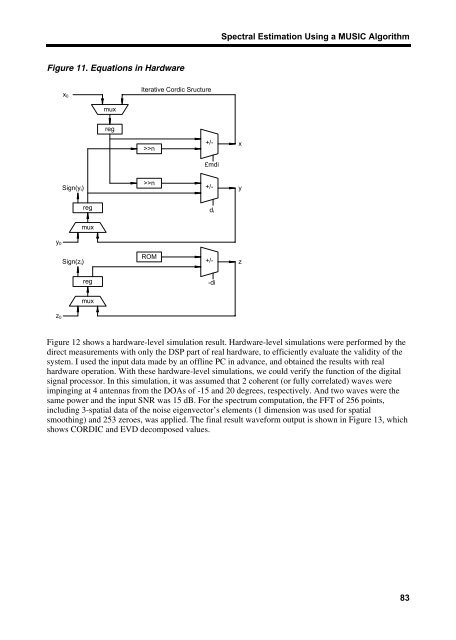Spectral Estimation Using a MUSIC Algorithm - Altera
Spectral Estimation Using a MUSIC Algorithm - Altera
Spectral Estimation Using a MUSIC Algorithm - Altera
You also want an ePaper? Increase the reach of your titles
YUMPU automatically turns print PDFs into web optimized ePapers that Google loves.
<strong>Spectral</strong> <strong>Estimation</strong> <strong>Using</strong> a <strong>MUSIC</strong> <strong>Algorithm</strong><br />
Figure 11. Equations in Hardware<br />
Iterative Cordic Sructure<br />
mux<br />
reg<br />
+/-<br />
>>n<br />
£mdi<br />
>>n<br />
Sign(y i )<br />
+/-<br />
reg<br />
mux<br />
y 0<br />
ROM<br />
Sign(z i )<br />
+/-<br />
reg<br />
-di<br />
mux<br />
z 0<br />
x 0<br />
d i<br />
x<br />
y<br />
z<br />
Figure 12 shows a hardware-level simulation result. Hardware-level simulations were performed by the<br />
direct measurements with only the DSP part of real hardware, to efficiently evaluate the validity of the<br />
system. I used the input data made by an offline PC in advance, and obtained the results with real<br />
hardware operation. With these hardware-level simulations, we could verify the function of the digital<br />
signal processor. In this simulation, it was assumed that 2 coherent (or fully correlated) waves were<br />
impinging at 4 antennas from the DOAs of -15 and 20 degrees, respectively. And two waves were the<br />
same power and the input SNR was 15 dB. For the spectrum computation, the FFT of 256 points,<br />
including 3-spatial data of the noise eigenvector’s elements (1 dimension was used for spatial<br />
smoothing) and 253 zeroes, was applied. The final result waveform output is shown in Figure 13, which<br />
shows CORDIC and EVD decomposed values.<br />
83
















